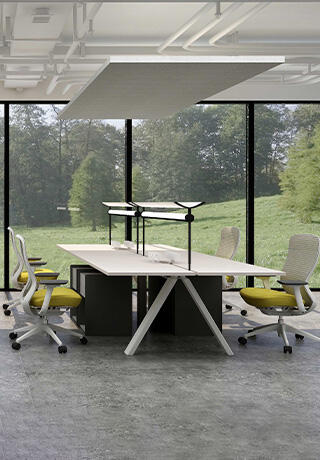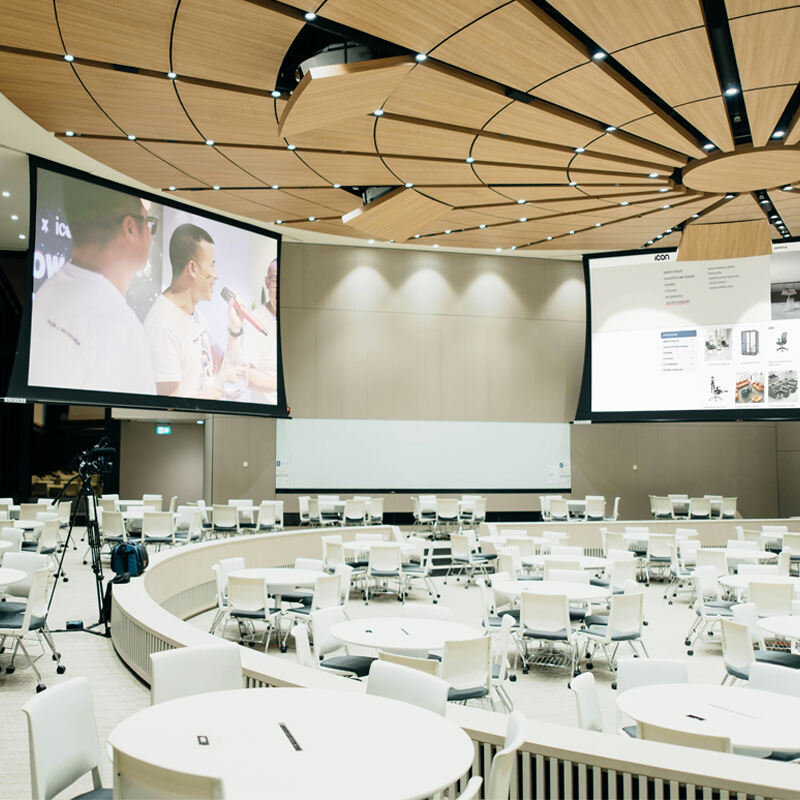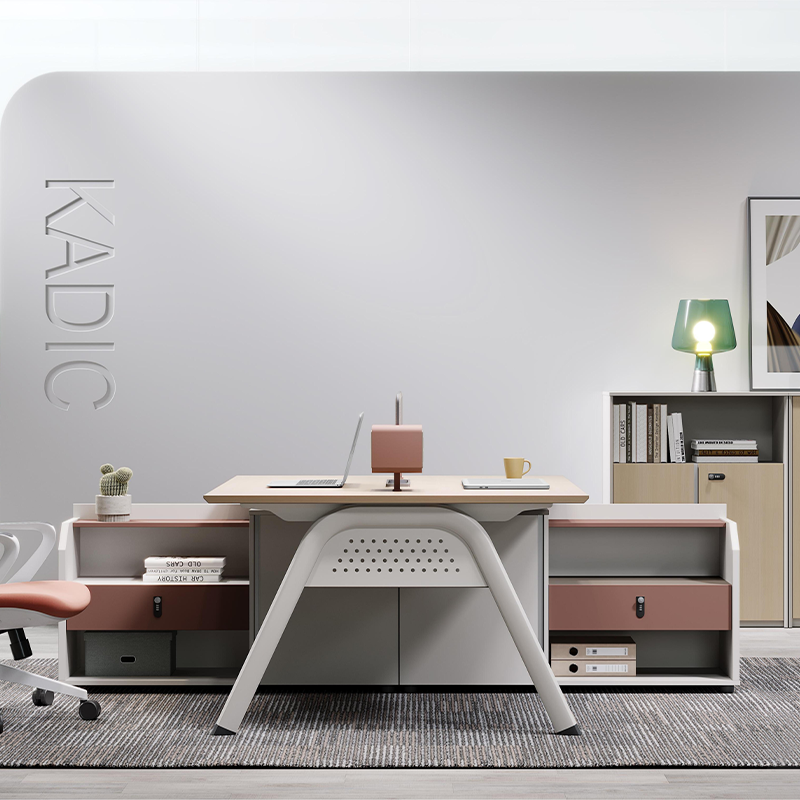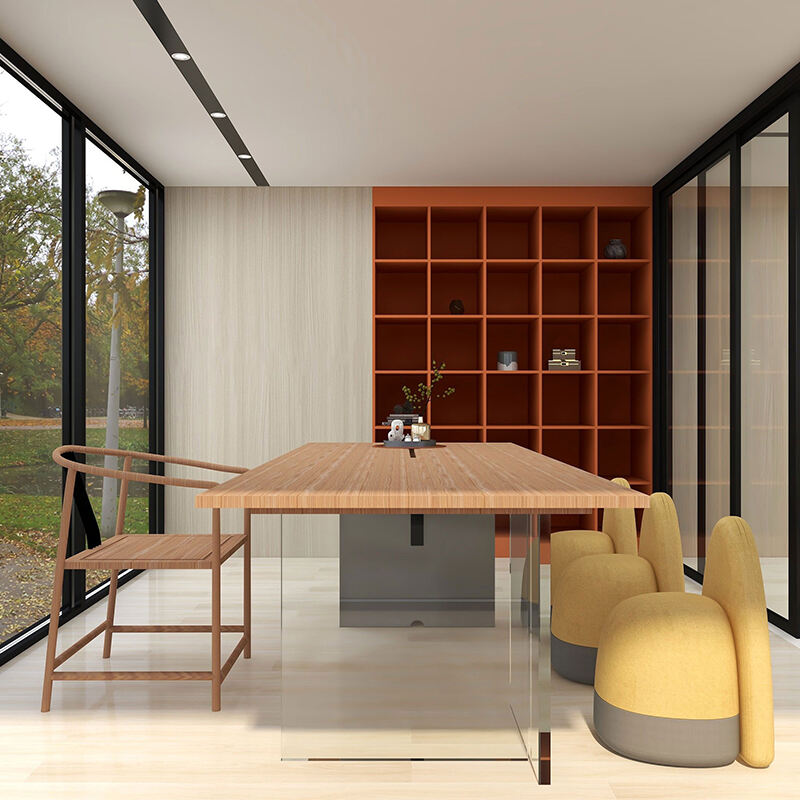كيف تكون عالي الجودة أثاث المكاتب تُحفّز إنتاجية الموظفين
تصميم إرغوني وتركيز أفضل
الأثاث المكتبي عالي الجودة والمصمم مع الأخذ في الاعتبار علم الإرگونوميا يحسن بشكل كبير من تركيز الموظفين عن طريق دعم الوضعية الطبيعية. يقلل الترتيب الإرگونومي، الذي غالبًا ما يتضمن وضع الشاشات والمقاعد بشكل صحيح، من عدم الراحة والتشتت، مما يسمح للموظفين بالحفاظ على التركيز. على سبيل المثال، تشير الأبحاث إلى أن البيئات المكتبية المجهزة بأثاث مصمم جيدًا تشهد زيادة بنسبة 20-25٪ في الإنتاجية. يُعزى ذلك إلى تقليل الانزعاج الجسدي وتحسين تناسق الجسم. من خلال ضمان أن يكون الأثاث ميسّرًا للوضعية الصحيحة وتقليل الضغط، يمكن للشركات إنشاء بيئة حيث يكون التركيز المستدام والإنتاجية هي القاعدة وليس الاستثناء.
تأثير الراحة المباشر على كفاءة العمل
الأثاث المكتبي المريح له علاقة مباشرة بتحسين كفاءة العمل وروح الموظفين. عندما يتم توفير مقاعد تركز على الراحة للموظفين، تشير الإحصائيات إلى زيادة ملحوظة بنسبة 15٪ في كفاءة عملهم. يساعد الأثاث المريح في خلق جو إيجابي، مما يمكّن الموظفين من الانخراط بشكل كامل في مهامهم دون الحاجة إلى فترات راحة متكررة بسبب عدم الراحة. وبما أن الروح المعنوية ترتفع، يشعر الموظفون بأنهم أكثر تقديرًا وتحفيزًا، مما يساهم في زيادة الإنتاجية العامة. وبالتالي، فإن الراحة ليست مجرد مسألة سهولة جسدية، بل استثمار استراتيجي لضمان بيئة عمل متوازنة وكفؤة.
تقليل التعب للحفاظ على الإنتاجية
الاستثمار في أثاث مكتبي عالي الجودة أمر حيوي لتقليل الإجهاد البدني، مما يسمح بإنتاجية عمل مستدامة لفترة أطول. تلعب الحلول المريحة دورًا محوريًا في هذا السياق، حيث أظهرت الدراسات أن الموظفين الذين يستخدمون أثاثًا مريحًا يشعرون بـ 30٪ أقل من الإرهاق مقارنةً بالذين يستخدمون الخيارات القياسية. من خلال معالجة الشكاوى الشائعة مثل ألم الظهر والتوتر العضلي، فإن الأثاث المصمم بطريقة مريحة يخفف هذه المشكلات، مما يمكّن الموظفين من العمل لساعات أطول بشكل منتج. تعتبر مثل هذه الاعتبارات أساسية في تصميم أماكن العمل التي لا تقتصر فقط على رعاية صحة الموظفين ولكن أيضًا تعزيز قدرتهم على الحفاظ على مستويات إنتاجية عالية طوال اليوم.
تقليل تكاليف الصحة والغياب من خلال الحلول المريحة
الوقاية من اضطرابات الجهاز العضلي الهيكلي
الاستثمار في الأثاث المكتبي الأرجونومي أمر حاسم لتقليل مخاطر اضطرابات الجهاز العضلي الهيكلي (MSDs)، والتي تؤدي إلى مشاكل صحية طويلة الأمد. وفقًا لمركز السيطرة على الأمراض (CDC)، تمثل اضطرابات الجهاز العضلي الهيكلي 34٪ من جميع إصابات أماكن العمل، مما يؤكد أهمية التدخلات الأرجونومية في إنشاء بيئة عمل أكثر أمانًا. يلعب الجلوس الداعم دورًا محوريًا في الوقاية من الشكاوى الشائعة مثل آلام الظهر والرقبة، التي غالبًا ما تؤدي إلى زيادة الغياب عن العمل. من خلال تنفيذ حلول أرجونومية، يمكن للشركات ليس فقط حماية صحة الموظفين ولكن أيضًا تقليل معدلات الغياب والتكلفة الصحية المتعلقة بها.
مبادرات الرفاهية طويلة الأمد
الأثاث الأرجونومي ليس مجرد مسألة راحة فورية؛ فهو عنصر حيوي من المبادرات طويلة الأمد التي تهدف إلى تحسين صحة ورضا الموظفين. تشير الدراسات إلى أن المؤسسات التي تولي اهتماماً بالصحة تشهد انخفاضاً بنسبة 25٪ في تكاليف الرعاية الصحية والغياب. الاستثمارات المستمرة في صحة الموظفين تسهم في بناء ثقافة عمل إيجابية، مما يخلق بيئة حيث يشعر الموظفون بأنهم مقدر عليهم ومدعومون. هذا التركيز على المبادرات الصحية يفيد ليس فقط الموظفين ولكن أيضاً يعزز من كفاءة وانخراط القوى العاملة.
العلاقة بين الراحة ونسب الحضور
تُظهر أماكن العمل المريحة رابطًا مثبتًا مع معدلات حضور أعلى وانخفاض معدل دوران الموظفين، مما يعكس التزامًا موظفًا أكبر. تشير الدراسات المؤسسية إلى تحسن بنسبة 15٪ في الحضور عند تنفيذ حلول إرゴنوميكية. من خلال توفير الأثاث المكتبي المناسب، تزرع الشركات قوة عاملة أكثر التزامًا وانخراطًا، مما يؤدي في النهاية إلى نجاح المنظمة. يعزز بيئة عمل مريحة جوًّا من التفاني، ويحث الموظفين على المشاركة بنشاط وانتظام في أدوارهم.
رفع مستوى إدراك العلامة التجارية من خلال الفضاءات المهنية
انطباعات العملاء والمصداقية المؤسسية
الاستثمار في أثاث مكتبي عالي الجودة لا يعزز الراحة فقط، بل يشكل أيضًا بشكل كبير انطباعات العملاء عن العلامة التجارية ومصداقية الشركة. المكتب المجهز جيدًا يرسل إشارة قوية للعملاء بأنك ملتزم بالاحترافية والجودة، مما قد يؤثر على انطباعاتهم الأولى. تشير الإحصائيات إلى أن نسبة مذهلة تصل إلى 78٪ من العملاء يشكلون آراءهم بناءً على مظهر مكان العمل فقط. لذلك، دمج أثاث مكتبي مصمم بعناية يمكن أن ينقل قيم علامة الشركة التجارية، مما يخلق بيئة تعزز الثقة والمصداقية وتحسن من انطباعات العملاء.
توافق الجماليات مع قيم الشركة
توحيد الجماليات للأثاث المكتبي مع القيم المؤسسية يمكن أن يعزز الرسالة التجارية الموحدة. هذا التوافق يؤثر بشكل قوي على العملاء والموظفين على حد سواء، حيث يعكس صفات المنظمة مثل الابتكار، الاستدامة، أو التقليد. الخيارات المخصصة للأثاث توفر للشركات القدرة على التعبير عن القيم المحددة من خلال تصميم المكتب. الأدلة تشير إلى أن الشركات التي لديها توافق جمالي تميل إلى الاحتفاظ بعدد أكبر من العملاء بسبب القيم المشتركة، مما يقوي الروابط خارج المعاملات التجارية الفورية.
الأثاث كسفير-brand صامت
الأثاث المكتبي عالي الجودة يلعب دور سفير للعلامة التجارية دون أن يقول كلمة واحدة، حيث يمثل قيم وهوية شركتك. يمكن لتصميم وجودة الأثاث أن تؤثر على التفاعلات بين الموظفين والعملاء، مما تعزز العلامة التجارية بشكل غير مباشر. تشير الدراسات إلى أن 70٪ من الموظفين يشعرون بالتحفيز عند رؤية مساحة عملهم متوافقة مع هوية العلامة التجارية. الاستثمار في الأثاث المناسب يتحول ببيئة المكتب، ليخلق مكانًا مشوقًا يشجع على الإنتاجية ويعكس جوهر علامتك التجارية.
كفاءة التكلفة لاستثمارات الأثاث المكتبي المتين
جودة المواد مقابل دورة الاستبدال
الاستثمار في مواد عالية الجودة للأثاث المكتبي يقلل بشكل كبير من دورة الاستبدال، مما يخفض التكاليف الإجمالية في النهاية. من خلال اختيار الحلول الدائمة بدلاً من البدائل الأرخص، يمكن للشركات توفير ما يصل إلى 30% على المدى الطويل. كما أن التأثير البيئي ملحوظ؛ مع تقليل عدد الاستبدالات، يتم إنتاج نفايات أقل، مما يساهم في تحقيق أهداف الاستدامة. وبالتالي، ليس فقط الاستثمار في الجودة يوفر المال، ولكنه يتوافق أيضًا مع أهداف المسؤولية الاجتماعية للشركات من خلال تقليل الأذى البيئي.
قيمة إعادة البيع وطول عمر الأصل
الأثاث المكتبي المتين يحتفظ بقيمة بيع أعلى، مما يقدم للشركات عائد استثمار لافت عندما يقررون الترقية. تشير الإحصائيات إلى أن الأثاث ذي الجودة يمكن أن يحتفظ بما يصل إلى 50% من قيمته حتى بعد سنوات عديدة من الاستخدام. يسمح هذا الدور المالي بإعادة الاستثمار في أثاث جديد ومتميز دون الضغط المالي المعتاد، مما يضمن أن يكون بيئة العمل حديثة ومريحة دائمًا.
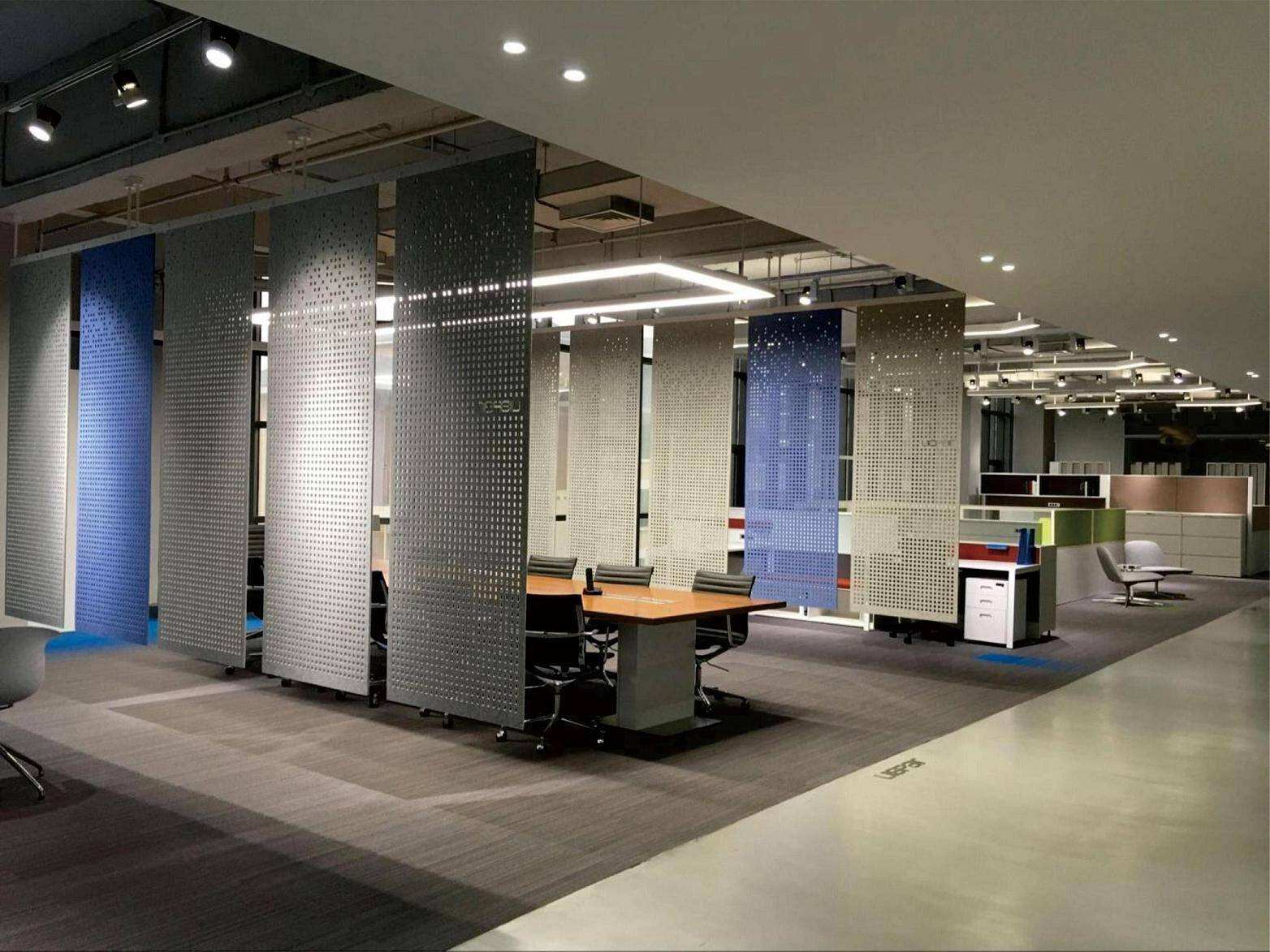
تقليل الاضطراب الناتج عن ترقية الأثاث
السر وراء الحفاظ على الإنتاجية أثناء ترقية الأثاث يكمن في جودة الأثاث المكتبي المختار. الخيارات عالية الجودة غالبًا ما تتطلب استبدالًا أقل تكرارًا، مما يقلل من الاضطرابات المرتبطة عادةً بالترقيات. يمكن للشركات تقليل التوقف عن العمل بنسبة تصل إلى 40٪ مع تركيبات أثاث مخططة بشكل جيد. تنفيذ استراتيجيات مثل إخراج الأثاث القديم تدريجيًا مع تقديم قطع جديدة يضمن انتقالًا سلسًا، ومنع الانقطاعات الكبيرة في سير العمل والحفاظ على مستويات إنتاجية مرتفعة.
حساب العائد الحقيقي على الاستثمار للأثاث المكتبي الفاخر
قياس مكاسب الإنتاجية بالدولارات
يشمل حساب العائد على الاستثمار (ROI) الخاص بأثاث المكاتب أكثر من مجرد تكلفة الشراء الأولية؛ إذ يشمل أيضًا مكاسب الإنتاجية التي يمكن تحويلها إلى قيمة نقدية. أظهرت الأبحاث أن تحسين بيئات العمل يمكن أن يزيد الإنتاجية بشكل كبير، مما قد يترجم إلى آلاف الدولارات لكل موظف سنويًا. بالنسبة للشركات، هذا يعني أن الاستثمارات في أثاث مكتبية ذات جودة عالية لا تتعلق فقط بالجوانب الجمالية أو الراحة، بل أيضًا بخلق بيئة تعزز أقصى إنتاجية للعمل. من خلال وضع مقاييس واضحة للإنتاجية، يمكن للشركات تبرير التكلفة الأولية للأثاث الفاخر نظرًا لمساهمته في النمو الكلي للإيرادات.
موازنة التكاليف الأولية مع توفير 7 سنوات
تحليل التوازن بين التكاليف الأولية والاقتصاد على المدى الطويل هو أمر حيوي عند الاستثمار في أثاث مكتبي فاخر. وعلى الرغم من أن النفقات الأولية قد تكون أعلى، تقدر الدراسات وفرًا محتملاً يصل إلى 20% على مدى سبعة أعوام عند أخذ التكاليف التشغيلية والصيانة الأقل للأصناف ذات الجودة العالية في الاعتبار. من خلال تطوير نموذج مالي يشمل هذه المتغيرات، يمكن للشركات أن توضح بوضوح الفوائد المالية طويلة الأمد للاستثمار في أثاث مكتبي متين ذو جودة عالية. هذا النهج الاستراتيجي يضمن أن الاستثمار يكون ليس فقط فعالاً من حيث التكلفة ولكن يدعم أيضًا النمو المالي المستدام.
الفوائد غير المباشرة من احتفاظ الموظفين
الاستثمار في الأثاث المكتبي يمكن أن يؤثر بشكل كبير على الاحتفاظ بالموظفين، مما يؤدي بشكل غير مباشر إلى توفير مالي من خلال تقليل تكاليف التوظيف والتدريب. تشير الدراسات إلى انخفاض بنسبة 25٪ في معدلات الاستقالة في أماكن العمل التي توفر أثاثًا مريحًا وداعمًا، مما يبرز أهمية الحفاظ على قوة عمل مستقرة وذات خبرة. تظهر هذه الفوائد المالية غير المباشرة من خلال تقليل الأنشطة المرتبطة بالتوظيف وزيادة رضا الموظفين، مما يؤكد دور بيئات المكتب في الاحتفاظ بالمواهب. هذا لا يقلل فقط من التكاليف ولكن أيضًا يعزز الجو العام للعمل، ويروج لقوة عمل أكثر انخراطًا وكفاءة.
أسئلة شائعة
لماذا الأثاث المكتبي الإرغوني مهم لإنتاجية العمل؟
الأثاث المكتبي الإرغوني يدعم الوضع الطبيعي، ويقلل من عدم الراحة والتشتت، ويساعد على الحفاظ على التركيز، مما يؤدي إلى زيادة الإنتاجية.
كيف يساهم الأثاث المريح في تحسين كفاءة العمل؟
الأثاث المريح يقلل من الحاجة إلى فترات الراحة المتكررة، ويعزز الروح المعنوية، ويزيد من كفاءة العمل عن طريق توفير بيئة عمل إيجابية.
هل يمكن أن يؤثر الأثاث المكتبي عالي الجودة على انطباعات العملاء عن العلامة التجارية للشركة؟
نعم، المكتب المجهز جيدًا يعزز من انطباعات العملاء عن العلامة التجارية من خلال إظهار احترافية وجودة تتناسب مع قيم الشركة.
ما هي الفوائد التكلفة للاستثمار في أثاث مكتبي متين؟
الأثاث المتين يقلل من دورة الاستبدال، مما يقدم وفرًا طويل الأمد ويحافظ على قيمة البيع المستعملة، مما يجعله استثمارًا اقتصاديًا فعالًا.

